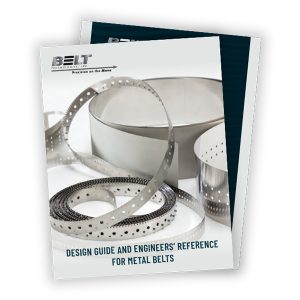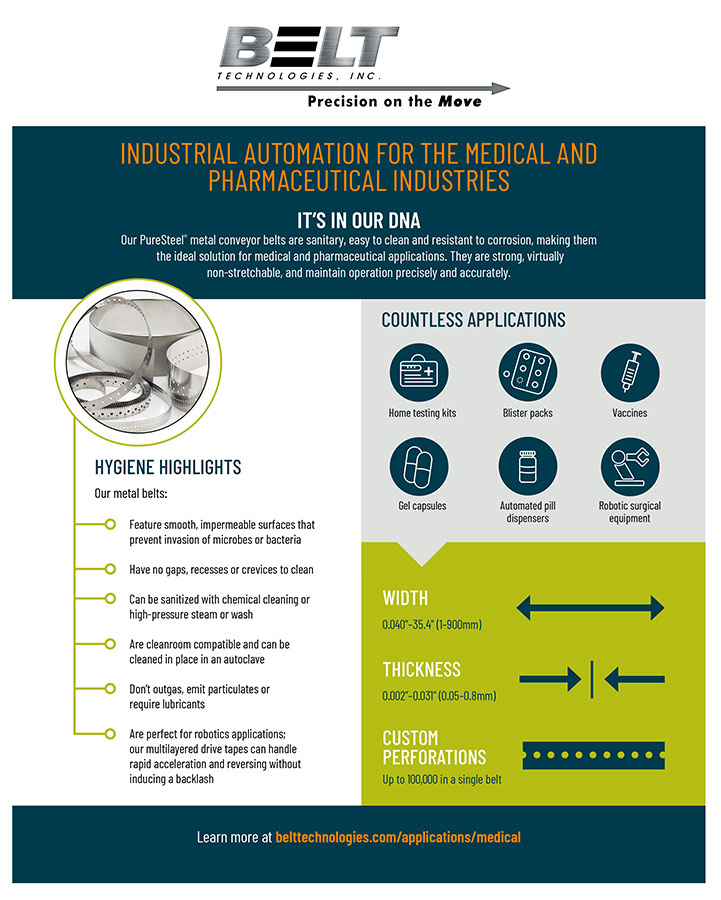For many obvious reasons, industrial automation for the medical and pharmaceutical industries is heavily regulated for safety and hygiene. This means any automated conveyor system used in these operations must be completely sanitary, easy to clean and resistant to corrosion. Forget rubber or plastic—stainless steel conveyor belts fit the bill for all these requirements.
Our PureSteel® metal conveyor belts play a significant role in medical and pharmaceutical manufacturing, offering superior precision control, hygiene and customization options.
Applications are myriad, including the:
- production and distribution of home DNA and diabetes tests.
- manufacture of blister packs for pills and tablets.
- processing and packaging of vaccines.
- production of gel capsules.
- automated dispensation of pills.
- creation of robotic operating equipment.
- manufacture of oncology and radiography equipment.
Hygiene Is a Given
It’s no coincidence that equipment that comes in contact with medical products is often made with austenitic stainless steel 304L or 316L. Our belts are available in these and a variety of other alloys with smooth, impermeable surfaces that offer no opportunity for the invasion of microbes or bacteria.
Although popular, polymer, plastic and metal mesh conveyors can generate particulates, making them limited in their hygienic capabilities and possibly increasing the risk of contamination. (See how we helped a UK-based conveyor manufacturer overcome the hygiene and strength limitations of plastic-tooth belts to facilitate a 17-fold increase in vaccine production at the height of the COVID-19 pandemic.)
The complete lack of gaps, recesses and crevices also makes stainless steel easier to clean. Due to its corrosion resistance, it can even be sanitized by high-pressure steam, high-pressure wash or chemical cleaning.
In addition, our belts do not require any lubricants that could introduce foreign substances into cleanroom environments. Their sterilization process can be performed in an autoclave, so they can be cleaned in place and don’t need to be removed from the conveyor for regular cleaning, which interrupts production.
Because Precision Matters
When compared with other power transmission or motion control components (linear actuators, lead screws, chains), metal belts are superior because of their high strength-to-weight ratio, durability and precise positioning. And unlike other belt types (such as rubber and fiberglass), metal belts will not stretch, so variations in surface speed are minimized.
Additionally, metal belts can be “stacked” in a multilayer configuration, consisting of several bands ranging in thickness from 0.003 to 0.005 inches [0.12 to 0.20 mm]. This configuration provides the combined strength of all layers while retaining the reduced bending stress of each individual layer, increasing the modulus of elasticity and helping to resist backlash.
The stacked configuration improves the strength of the belt without sacrificing precision or flexibility in tight spaces—an ideal scenario for robotic surgery applications (like this one, which required a solution that was small and strong with zero risk of backlash).
Customized to Your Exact Needs
When it comes to customization, the most important element is a belt’s pitch profile—the space between individual perforations, timing pins or other such features on a conveyor. Perforations are created by mechanical presses, chemical etching or laser cutting.
While custom pitch profiles vary by manufacturer, we can create countless perforation patterns in stainless steel belts as thin as 0.002 inches [0.08 mm], and as wide as 36 inches [900 mm]. This capability was “just what the doctor ordered” for this manufacturer of custom medical device machinery who had a need for very specific pitches.
Other customization options include a large array of metal alloys, unique belt width and thickness combinations, numerous surface coatings and textures, custom attachments and unlimited travel lengths.
Critical Solutions
For more than 50 years, we have produced PureSteel® metal conveyor belts, timing belts and pulleys ideally designed for industrial automation for the medical and pharmaceutical industries. Put us to the test. Bring us your challenge and see how our innovative team addresses it head on while maintaining standards for the most stringent levels of safety and hygiene.



